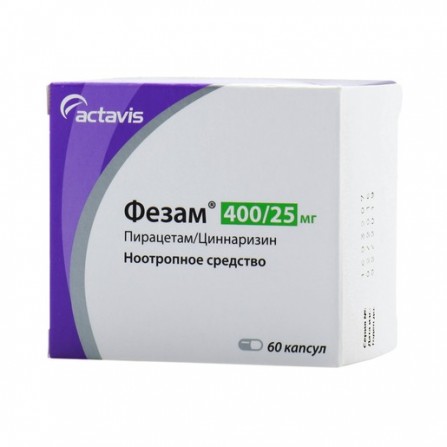More info
Active ingredients
Piracetam + Cinnarizine
Release form
Capsules
Composition
Piracetam: 400 mg. Cinnarizine: 25 mg. Additional substances: lactose, silica, magnesium stearate, gelatin.
Pharmacological effect
The combined drug with a pronounced antihypoxic, nootropic and vasodilating action. The components mutually potentiate a decrease in the resistance of the cerebral vessels and contribute to an increase in blood flow in them. Piracetam is a nootropic agent. It activates metabolic processes in the brain by increasing energy and protein metabolism, accelerating the utilization of glucose by cells and increasing their resistance to hypoxia. It improves interneuronal transmission in the central nervous system and regional blood flow in the ischemic zone. Cinnarizine is a selective blocker of slow calcium channels and an antagonist of histamine H1 receptors. It has been established that it inhibits the entry of calcium ions into the cells and reduces their content in the plasmolemma depot. Reduces the tone of the smooth muscles of arterioles, reduces their response to biogenic vasoconstrictor substances (catecholamines, angiotensin and vasopressin). It has a vasodilating effect (especially in relation to the vessels of the brain, enhancing the antihypoxic effect of piracetam), without having a significant effect on blood pressure. Shows moderate antihistamine activity, reduces the excitability of the vestibular apparatus, increases the tone of the sympathetic nervous system. Increases the elasticity of erythrocyte membranes, their ability to deform, reduces blood viscosity.
Pharmacokinetics
Absorption: After ingestion, the drug is completely absorbed from the gastrointestinal tract. Piracetam is created in plasma after 2-6 hours. Piracetam has 100% bioavailability. Cinnarizine has a slow absorption. Plasma cinnarizine is achieved after 1-4 hours. Distribution: Piracetam does not bind to plasma proteins. The apparent Vd is about 0.6 l / kg. Piracetam freely penetrates the BBB. Cram piracetam in cerebrospinal fluid is reached in 2-8 hours. It penetrates into all organs and tissues, penetrates the placental barrier. Selectively accumulates in the cerebral cortex, mainly in the frontal, parietal and occipital lobes, cerebellum and basal ganglia. Cinnarizine binds to plasma proteins 91%. Metabolism: Is not metabolized by piracetam. Cinnarizine is actively and completely metabolized in the liver by dealkylation with the participation of isoferment CYP2D6. Extraction: T1 / 2 piracetam from plasma is 4-5 h, from cerebrospinal fluid - 8.5 h.80-100% of piracetam is excreted by the kidneys unchanged by renal filtration. The renal clearance of piracetam in healthy volunteers is 86 ml / min. T1 / 2 of cinnarizine - 4 h. 1/3 of the metabolites are excreted in the urine, 2/3 with feces. The pharmacokinetics of piracetam does not change in patients with liver failure. Gets through the filtering membranes of hemodialysis machines.
Indications
Disorders of cerebral circulation due to stroke, vascular atherosclerosis, head injury. Disorders of cognitive functions: memory, thinking, attention. Decreased mood, irritability. Encephalopathy of various origins. Labyrinthopathies. Meniere's disease. Migraine. Combined therapy of arterial hypertension. Combined therapy of hearing loss. Combined therapy NDC. Combined therapy of visual impairment with: myopia, macular dystrophy, angle-closure glaucoma (after stabilization of intraocular pressure). Disturbances of memory and attention in children, including those with reduced intelligence. Asthenia.
Contraindications
Intolerance to one of the components of the drug. Severe renal failure. Pregnancy period (1 trimester). Parkinsonism. Age up to 5 years.
Precautionary measures
Precautions should be prescribed the drug for Parkinson's disease, abnormal liver function and / or kidney, impaired hemostasis, severe bleeding.
Use during pregnancy and lactation
Despite the lack of data on the presence of teratogenic effects of piracetam and cinnarizine, Phezam is contraindicated for use during pregnancy. Piracetam is excreted in breast milk, so if you need to use the drug during lactation, breastfeeding should be stopped.
Dosage and administration
Adults: depending on the severity of the disease - 1-2 capsules 3 times a day. Children: depending on the severity of the disease - 1-2 capsules 1-2 times a day. The course of treatment is 1-3 months.
Side effects
Dyspeptic symptoms, allergic reactions, headache.
Overdose
Phezam is well tolerated by patients, in case of an overdose, there are no serious side effects requiring discontinuation of the drug. Symptoms: pain in the abdomen is possible. Treatment: gastric lavage should be performed, induce vomiting; symptomatic therapy; if necessary, hemodialysis. There is no specific antidote.
Interaction with other drugs
With simultaneous use with the drug Phezam, it is possible to enhance the sedative effect of the agents that inhibit the activity of the central nervous system, tricyclic antidepressants, and also ethanol.
special instructions
Caution should be given to patients with liver and / or kidney diseases. In case of mild to moderate renal failure (CC less than 60 ml / min), reduce the therapeutic dose or increase the interval between doses of the drug. Patients with impaired liver function should monitor liver enzymes .Patients should avoid drinking alcohol while taking Phezam. The drug enhances the activity of thyroid hormones and can cause tremors and anxiety. Effects on the ability to lead yu vehicles and management mechanisms: During ingestion Phezam patients should use caution when driving and working with machines and equipment, as early treatment cinnarizine may cause drowsiness.





